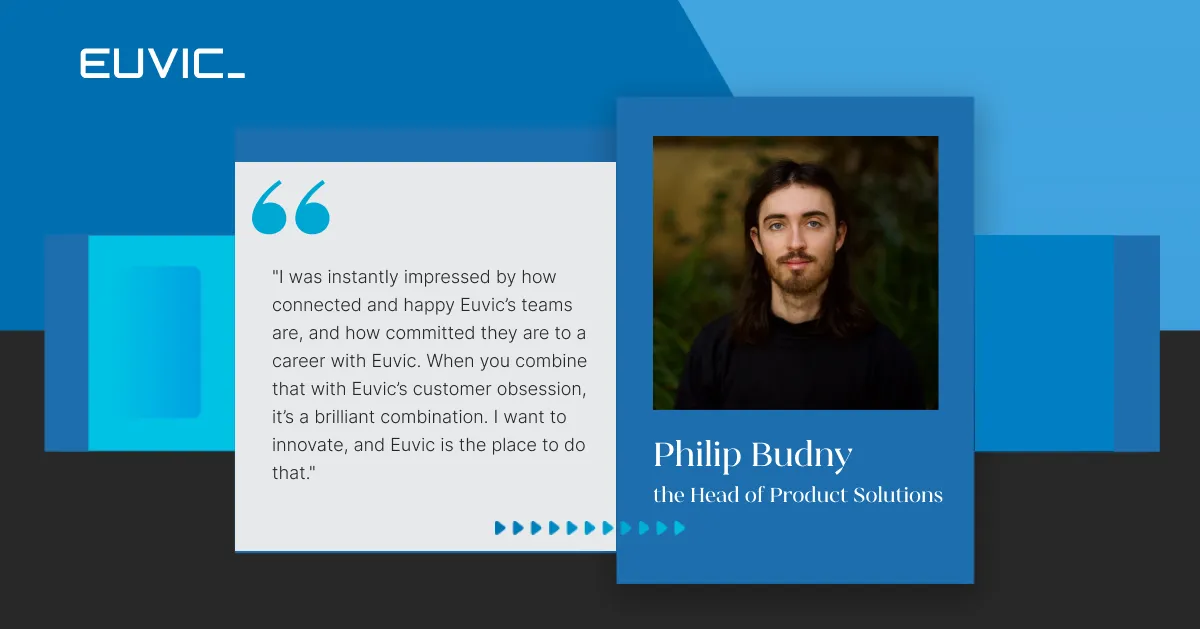Product Solutions Manager: Why Software Development Outsourcing Fails (And What The Best Partners Do Instead)
What makes a software development project truly successful?
Adherence to budget? Number of features developed? Speed of execution?
These staggering numbers reveal a fundamental truth: The metrics most companies use to measure “success” are completely wrong.
Yet most organizations still evaluate their outsourcing partnerships based on whether code gets delivered on time and within budget, not whether that code moves the business forward.
The real failure happens long before the first line of code is written. 45% of features in software projects are never used, which means companies are paying premium rates to build functionality that provides zero business value.
At Euvic, we’ve spent years watching clients struggle with this disconnect.
We saw talented development teams delivering exactly what was requested, only to watch those features sit unused.
We witnessed partnerships dissolve not because of poor code quality, but because the software didn’t drive the business results clients truly needed.
That’s why we created the Product Solutions Manager (PSM) framework.
PSMs bridge the gap between business strategy and technical execution, making sure every development decision serves a measurable business purpose.
Here’s exactly how they do that.
The Hidden Epidemic: Why Software Outsourcing Partnerships Consistently Fail
Picture this: You hire a top-rated development team with stellar reviews and an impressive portfolio. They deliver clean, well-documented code on time and under budget. Six months later, user adoption sits at 12%, key features collect digital dust, and your internal stakeholders are asking what went wrong. Sound familiar?
This scenario plays out thousands of times each year because the traditional outsourcing model contains a fundamental flaw: vendors get rewarded for what they build, not what succeeds in the market.
The Vendor Optimization Trap
Most development teams optimize for efficiency and deliverable completion, which are metrics that make perfect sense from their perspective. They’re measured on velocity, code quality, and meeting deadlines. But here’s the problem: none of these metrics connect to whether the software actually solves business problems or drives user adoption.
When shipping features rather than achieving outcomes defines a vendor’s success, you get exactly what you pay for: efficiently built software that might be completely irrelevant to your business goals.
The Three Project Failure Patterns Most Vendors Fall Into
After years of working with clients who came to us after failed partnerships, we’ve identified three recurring patterns that doom outsourcing relationships from the start:
Pattern 1. The Feature Factory Pattern: Clients provide a list of requirements. Vendors build exactly what’s specified. No one questions whether these features solve the actual business problem. The result? Perfectly executed solutions to the wrong problems.
Pattern 2. The Translation Problem: Business needs get filtered through multiple layers, from stakeholders to project managers to technical leads to developers. Each layer introduces interpretation and potential misunderstanding. By the time requirements reach the coding team, they bear little resemblance to the original business intent.
Pattern 3. The Scope Drift Spiral: Markets change. User feedback arrives. Competitive pressures shift priorities. But traditional vendor relationships lack the framework to evaluate these changes through a business lens.
Why This Keeps Happening
The fundamental issue is incentive alignment, not execution ability. Poor requirements gathering is cited as the leading cause in 39% of failures, but that’s treating the symptom, not the disease.
The real problem is that traditional outsourcing relationships don’t give vendors the context, authority, or motivation to question requirements or suggest better alternatives.
Most vendors operate in a black box, isolated from business strategy, user feedback, and market context. They optimize for what they can control (technical execution) while remaining blind to what actually matters: business impact.
The companies breaking free from these failure patterns have realized something important: the solution isn’t better project management or clearer documentation. It’s fundamentally rethinking what role your development partner should play in your business success.
What Is A Product Solutions Manager And Why Do You Need One?
After watching countless partnerships fail due to the disconnect between technical execution and business outcomes, we developed a completely different approach: the Product Solutions Manager (PSM).
Traditional project managers focus on the “what” and “when”. PSMs focus on the “why”. PSMs understand the business problems that need solving and the outcomes that define success.
How The PSM Framework Works: Three Levels of Strategic Partnership
Not every client needs the same level of strategic involvement from day one. That’s why we built the PSM framework around three distinct tiers that allow partnerships to evolve based on trust, business needs, and project complexity.
Tier 1: Partnership Foundation
What it includes: Communication facilitation, quality oversight, and a cultural bridge between US clients and development teams.
Why it works: We consider this the baseline for any successful outsourcing partnership. Without solid communication and quality foundations, projects fail regardless of technical capability.
What problems PSMs solve at this tier:
- Time zone coordination and cultural translation
- Proactive identification of potential issues before they become problems
- Quality assurance that goes beyond code review to include business relevance
- Clear communication channels that prevent the “telephone game” effect
Tier 2: Strategic Product Consulting (Value-Added Service)
What it includes: KPI definition, strategic guidance, product best practices, and business outcome alignment.
When you need it: When you want more than execution. You want strategic input on what to build and why.
What problems PSMs solve at this tier:
- Misalignment between features built and business goals achieved
- Lack of clear success metrics beyond timeline and budget
- Need for product management expertise without hiring full-time product managers
- Strategic decision-making support for product direction
Instead of just building the requested “customer forum,” a Tier 2 PSM would ask: “Are you trying to reduce support tickets, build community, or create a knowledge base? What evidence do we have that a forum achieves that goal? Should we test other solutions first?”
Tier 3: Embedded Product Management (Full Partnership)
What it includes: Full product strategy ownership, deep domain expertise, and acting as your distributed product manager.
When you need it: When you lack internal product management capability or want to scale your product team without full-time hires.
What problems PSMs solve at this tier:
- Complete absence of product management expertise
- Need for someone who owns product outcomes, not just delivery
- Requirement for deep vertical knowledge and market understanding
- Long-term product strategy and roadmap development
What Happens Without a PSM: The Drift Problem
Understanding what PSMs prevent is just as important as understanding what they provide. Without strategic oversight, even the most talented development teams can drift away from business objectives.
The Efficiency vs. Effectiveness Trap
This efficiency is exactly what clients want until it works against them. Highly efficient teams require clear, stable requirements. But software development is inherently iterative. Markets change, user feedback arrives, and competitive pressures shift priorities.
Without a PSM these changes become expensive “scope creep” orders that derail budgets and timelines.
With a PSM these changes become strategic pivots or opportunities to improve business outcomes based on new information.
The Small Misalignment Compound Effect
Here’s how small misalignments compound:
- Month 1: Client mentions wanting to “improve customer engagement”
- Month 1: The Development team interprets this as “add more interactive features”
- Month 2: Features are built that increase time-on-site but don’t drive business metrics
- Month 2: Client realizes the features aren’t moving revenue or retention numbers
- Month 3: Relationship deteriorates because “engagement” meant different things to different people
The Communication Breakdown Pattern
Without a PSM bridging communication gaps, projects often follow this pattern:
- Business stakeholder says: “We need to increase customer engagement”
- Project manager hears: “Build features that keep users on the site longer”
- Technical lead interprets: “Add interactive elements and gamification”
- Developer builds: Features that technically work but don’t solve the business problem
- Result: Perfectly executed solution to the wrong problem
PSMs And Skilled Execution Teams In Action
The relationship between development teams and business outcomes is all about strategic direction. Think about the most powerful car in the world: without proper steering, all that horsepower becomes dangerous rather than useful.
This is exactly what happens in traditional outsourcing relationships. You get exceptional technical execution, driving toward destinations that may no longer serve your business needs.
Traditional Outsourcing (No Strategic Steering):
- High-performance development team executes efficiently toward original requirements
- Market feedback arrives but gets treated as “scope creep” rather than strategic input
- Competitive landscape shifts but no one connects this to development priorities
- Project delivers exactly what was specified, which may no longer be what’s needed
- “Successful” delivery that fails to achieve business objectives
PSM-Enabled Partnership (Strategic Steering):
- High-performance development team provides execution power and speed
- PSM continuously monitors business metrics, user feedback, and market conditions
- Strategic adjustments happen proactively based on real-world data
- Development priorities adapt to serve evolving business needs
- Project delivers outcomes that drive measurable business value
Ready To Work With A Product Solutions Manager?
The traditional outsourcing model is fundamentally broken. While vendors optimize for deliverable completion, your business needs outcomes that drive growth, user adoption, and competitive advantage.
Product Solutions Managers represent a complete rethinking of how software development partnerships should work.
At Euvic, we’ve spent 20 years perfecting the balance between world-class Polish engineering talent and US-based strategic leadership. Our PSM framework has helped hundreds of clients turn their development investments into competitive advantages, with a 92% employee retention rate of top talent and over 1,000 successfully delivered projects.
See how you can work with a PSM today. Contact us for a complimentary consultation now.
Euvic is a competitive advantage for us. The technical excellence that Euvic has brought is not easily matched and their support has become integral to our growth strategy.

Euvic is a competitive advantage for us. The technical excellence that Euvic has brought is not easily matched and their support has become integral to our growth strategy.

Euvic is a competitive advantage for us. The technical excellence that Euvic has brought is not easily matched and their support has become integral to our growth strategy.

Talk to Your Local Euvic Team






.webp)











.webp)







































































